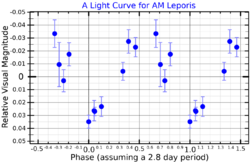Astronomy:Iota Leporis
| Observation data Equinox J2000.0]] (ICRS) | |
|---|---|
| Constellation | Lepus |
| Right ascension | 05h 12m 17.90190s[2] |
| Declination | −11° 52′ 09.1863″[2] |
| Apparent magnitude (V) | 4.45[3] |
| Characteristics | |
| Spectral type | B7.5 Vn[4] + K7.2 XR? + G8 Ve[5] |
| U−B color index | −0.40[3] |
| B−V color index | −0.10[3] |
| Astrometry | |
| Radial velocity (Rv) | +23.50[6] km/s |
| Proper motion (μ) | RA: +24.39[2] mas/yr Dec.: −31.02[2] mas/yr |
| Parallax (π) | 14.07 ± 0.16[2] mas |
| Distance | 232 ± 3 ly (71.1 ± 0.8 pc) |
| Absolute magnitude (MV) | 0.01[7] |
| Details | |
| ι Lep A | |
| Mass | 3.37±0.02[8] M☉ |
| Luminosity | 153[8] L☉ |
| Surface gravity (log g) | 4.25[9] cgs |
| Temperature | 13,781±469[9] K |
| Rotational velocity (v sin i) | 185[9] km/s |
| Age | 94[7] Myr |
| Other designations | |
| Database references | |
| SIMBAD | data |
Iota Leporis (ι Leporis) is a triple star[5] system in the southern constellation of Lepus. It is visible to the naked eye as a point source of blue-white light with an apparent visual magnitude of 4.45.[3] Based upon an annual parallax shift of 14.07 mas as measured from Earth,[2] the system is located roughly 232 light years from the Sun.
The primary, designated component A, is a B-type main-sequence star with a stellar classification of B7.5 Vn,[4] where the 'n' suffix indicates "nebulous" absorption lines caused by rotation. It is about 94[7] million years old and has a high rate of spin with a projected rotational velocity of 185 km/s.[9] With an estimated 3.4[8] times the mass of the Sun, it is radiating 153[8] times the Sun's luminosity from its photosphere at an effective temperature of around 13,781 K.[9]
There is a close companion that is a source of X-ray emission. Most likely this star has at least 1.05 times the mass of the Sun.[7] The third component, AM Leporis, is a BY Draconis variable[11] of apparent magnitude 9.92,[3] and spectral type G8Ve[12] at an angular separation of 12.7".[13]
References
- ↑ Huélamo, N.; Fernández, M.; Neuhäuser, R.; Wolk, S. J. (December 2004). "Rotation periods of Post-T Tauri stars in Lindroos systems". Astronomy and Astrophysics 428 (3): 953–967. doi:10.1051/0004-6361:20034442. Bibcode: 2004A&A...428..953H. https://www.aanda.org/articles/aa/pdf/2004/48/aa0442-03.pdf. Retrieved 29 June 2022.
- ↑ 2.0 2.1 2.2 2.3 2.4 2.5 van Leeuwen, F. (2007), "Validation of the new Hipparcos reduction", Astronomy and Astrophysics 474 (2): 653–664, doi:10.1051/0004-6361:20078357, Bibcode: 2007A&A...474..653V.
- ↑ 3.0 3.1 3.2 3.3 3.4 Ducati, J. R. (2002), "VizieR Online Data Catalog: Catalogue of Stellar Photometry in Johnson's 11-color system", CDS/ADC Collection of Electronic Catalogues 2237: 0, Bibcode: 2002yCat.2237....0D.
- ↑ 4.0 4.1 Garrison, R. F. et al. (1994), "The late B-type stars: refined MK classification, confrontation with Stromgren photometry, and the effects of rotation", The Astronomical Journal 107 (4): 1556–1564, doi:10.1086/116967, Bibcode: 1994AJ....107.1556G.
- ↑ 5.0 5.1 Eggleton, P. P.; Tokovinin, A. A. (September 2008), "A catalogue of multiplicity among bright stellar systems", Monthly Notices of the Royal Astronomical Society 389 (2): 869–879, doi:10.1111/j.1365-2966.2008.13596.x, Bibcode: 2008MNRAS.389..869E.
- ↑ Kharchenko, N. V. et al. (2007), "Astrophysical supplements to the ASCC-2.5: Ia. Radial velocities of ˜55000 stars and mean radial velocities of 516 Galactic open clusters and associations", Astronomische Nachrichten 328 (9): 889, doi:10.1002/asna.200710776, Bibcode: 2007AN....328..889K.
- ↑ 7.0 7.1 7.2 7.3 Hubrig, S. et al. (June 2001), "Search for low-mass PMS companions around X-ray selected late B stars", Astronomy and Astrophysics 372: 152–164, doi:10.1051/0004-6361:20010452, Bibcode: 2001A&A...372..152H.
- ↑ 8.0 8.1 8.2 8.3 Zorec, J.; Royer, F. (January 2012), "Rotational velocities of A-type stars. IV. Evolution of rotational velocities", Astronomy & Astrophysics 537: A120, doi:10.1051/0004-6361/201117691, Bibcode: 2012A&A...537A.120Z.
- ↑ 9.0 9.1 9.2 9.3 9.4 David, Trevor J.; Hillenbrand, Lynne A. (2015), "The Ages of Early-Type Stars: Strömgren Photometric Methods Calibrated, Validated, Tested, and Applied to Hosts and Prospective Hosts of Directly Imaged Exoplanets", The Astrophysical Journal 804 (2): 146, doi:10.1088/0004-637X/804/2/146, Bibcode: 2015ApJ...804..146D.
- ↑ "iot Lep". SIMBAD. Centre de données astronomiques de Strasbourg. http://simbad.u-strasbg.fr/simbad/sim-basic?Ident=iot+Lep.
- ↑ Kazarovets, E. V. et al. (2008), "The 79th name-list of variable stars", Information Bulletin on Variable Stars 5863 (1): 1, Bibcode: 2008IBVS.5863....1K.
- ↑ Gahm, G. F. et al. (1983), "A study of visual double stars with early type primaries. I - Spectroscopic results", Astronomy and Astrophysics Supplement Series 51: 143–159, Bibcode: 1983A&AS...51..143G.
- ↑ Dommanget, J. et al. (2002), "Catalog of Components of Double & Multiple stars", Observations et Travaux 54 (5), Bibcode: 2002yCat.1274....0D. Vizier result
 |


